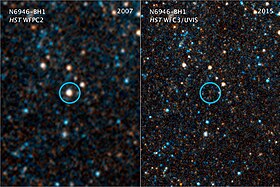 Pair of visible-light and near-infrared photos from NASA's Hubble Space Telescope showing N6946-BH1 before and after it vanished from sight | |
| Observation data Epoch J2000.0 Equinox J2000.0 | |
|---|---|
| Constellation | Cygnus |
| Right ascension | 20 35 27.56 |
| Declination | +60° 08′ 08.3″ |
| Apparent magnitude (V) | 18.17 (max) |
| Characteristics | |
| Variable type | suspected failed supernova |
| Astrometry | |
| Distance | 5,960,000 pc |
| Details | |
| Mass | 25 M☉ |
| Radius | 1,216–2,720 R☉ |
| Luminosity | 200,000–~1,000,000 L☉ |
| Temperature | 3,500 K |
| Database references | |
| SIMBAD | data |
N6946-BH1 is a disappearing supergiant star and failed supernova candidate formerly seen in the galaxy NGC 6946, on the northern border of the constellation of Cygnus. The star, either a red supergiant or a yellow hypergiant, was 25 times the mass of the Sun, and was 20 million light years distant from Earth. In March through to May 2009 its bolometric luminosity increased to at least a million solar luminosities, but by 2015 it had disappeared from optical view. In the mid and near infrared an object is still visible; however, it is fading away with a brightness proportional to t. The brightening was insufficient to be a supernova; the process that created the outburst is still uncertain.
The star's coordinates were at RA 20 35 27.56 and Dec +60° 08′ 08.3″. The brightness of the star, given by its apparent magnitude in different colour bands on 2 July 2005 is given by R = 21, V = 22, B = 23, U = 24. Prior to the optical outburst the star was about 100,000 times as bright as the Sun. After the outburst it was invisible in the visual band and has declined to 5,000 times as bright as the Sun in infrared radiation.

One hypothesis is that of the failed supernova. In this scenario, the core of the star collapsed to form a black hole. The collapsing matter formed a burst of neutrinos that lowered the total mass of the star by a fraction of a percent. This caused a shock wave that blasted out the star's envelope to make it brighter. N6946-BH1 has supplied evidence contrary to the conventional idea that black holes are usually formed after a supernova, suggesting instead that a star may bypass this eventuality and yet collapse into a black hole.
Observed type II supernovae do not originate from stars with initial masses greater than about 18 M☉, and the rate of large star formation appears to exceed the rate of supernovae. The expectation is that something else is happening to these extra large stars. Failed supernovae and black hole formation is one proposed explanation. If this event indeed reflected the formation of a black hole, it is the first time that black hole formation has been observed.
Observations from the James Webb Space Telescope show that all observations before it were a combination of at least three objects. The data the instrument collected matches that of a merger of two stars; however, the failed supernova hypothesis cannot be ruled out.
Notes
- Applying the Stefan-Boltzmann Law with a nominal solar effective temperature of 5,772 K:
- Applying the Stefan-Boltzmann Law with a nominal solar effective temperature of 5,772 K:
References
- ^ Adams, S. M.; Kochanek, C. S; Gerke, J. R.; Stanek, K. Z.; Dai, X. (9 September 2016). "The search for failed supernovae with the Large Binocular Telescope: confirmation of a disappearing star". Monthly Notices of the Royal Astronomical Society. 468 (4): 4968–4981. arXiv:1609.01283v1. Bibcode:2017MNRAS.468.4968A. doi:10.1093/mnras/stx816.
- ^ Gerke, J. R.; Kochanek, C. S.; Stanek, K. Z. (2015). "The search for failed supernovae with the Large Binocular Telescope: First candidates". Monthly Notices of the Royal Astronomical Society. 450 (3): 3289. arXiv:1411.1761. Bibcode:2015MNRAS.450.3289G. doi:10.1093/mnras/stv776.
- Humphreys, Roberta M. (2019-10-31). "Comments on the Progenitor of NGC 6946-BH1". Research Notes of the AAS. 3 (10): 164. arXiv:1911.02037. Bibcode:2019RNAAS...3..164H. doi:10.3847/2515-5172/ab5191. ISSN 2515-5172. S2CID 207880492.
- Williams, Matt (16 September 2016). "Have we really just seen the birth of a black hole?". PhysOrg. Retrieved 16 September 2016.
- "Biography in Context - Document". link.galegroup.com. Retrieved 2018-02-11.
- Nowogrodzki, Anna (12 September 2016). "First glimpse of a black hole being born from a star's remains". New Scientist. Retrieved 17 September 2016.
- Beasor, Emma R.; Hosseinzadeh, Griffin; Smith, Nathan; Davies, Ben; Jencson, Jacob E.; Pearson, Jeniveve; Sand, David J. (2023). "JWST reveals a luminous infrared source at the position of the failed supernova candidate N6946-BH1". The Astrophysical Journal. 964 (2): 171. arXiv:2309.16121. Bibcode:2024ApJ...964..171B. doi:10.3847/1538-4357/ad21fa.
External links
- N6946-BH1 Giant Star Becomes a Black Hole Right Before Our Eyes!

